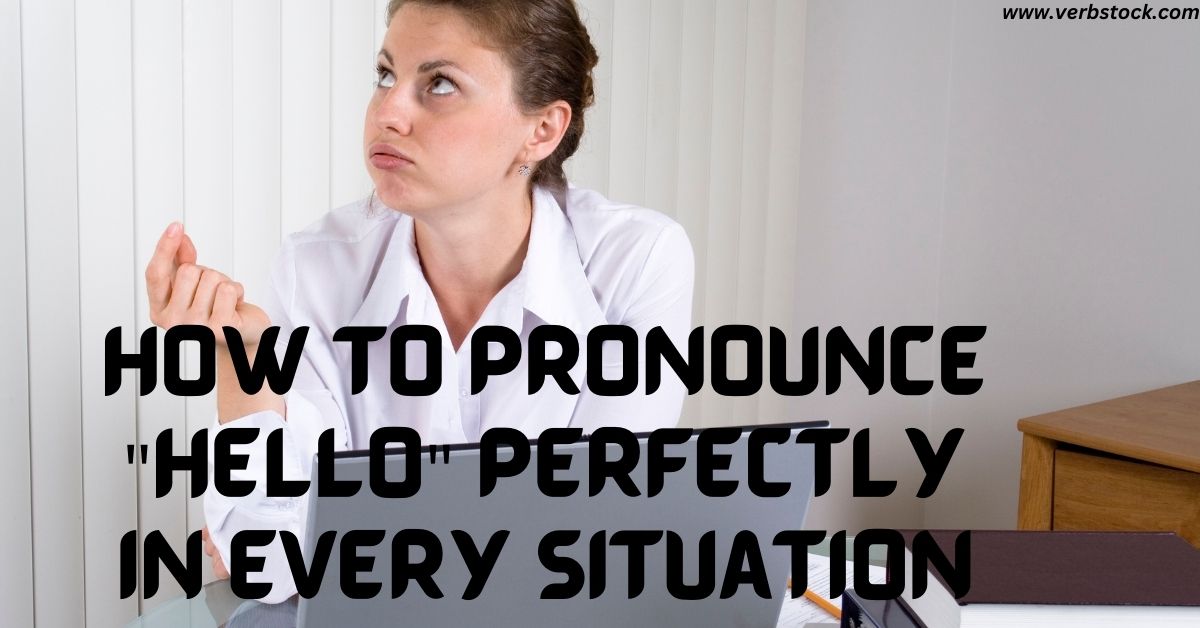“How to pronounce hello” refers to the correct way to say the word “hello” in English. It is the standard greeting used when meeting someone or answering the phone. Saying “hello” correctly helps you sound friendly and approachable.
Have you ever wondered if you’re saying “hello” the right way? Whether you’re speaking with friends or meeting someone new, your greeting sets the tone. Getting it right can make a great first impression.
To pronounce “hello” properly, you need to focus on the two syllables. The first part is soft, like “huh,” and the second part is clear, like “loh.” With practice, you’ll get the hang of it in no time.
How to Pronounce “Hello” Correctly in American English
First things first—let’s get the basics right. The correct way to pronounce “Hello” in American English is huh-LOH. Here’s a breakdown:
- Huh: This first syllable should be soft and airy, almost like you’re exhaling a gentle breath.
- LOH: The second syllable is pronounced with a clear “o” sound, like in the word “go,” not like “low.”
When combined, you get huh-LOH. The key is to make sure the “huh” sound is soft and not too heavy, while the “LOH” sound should be clear and distinct.
Common Mispronunciations of “Hello” and How to Fix Them
A lot of people accidentally mispronounce “Hello,” especially when they’re still getting used to the sounds in English. Here are a few common mistakes:
- HEL-oh: Some people overemphasize the first syllable.
- Tip: Soften the “huh” sound and shift the emphasis to the second syllable, “LOH.”
- huh-LAW: Mispronouncing the “o” as “aw.”
- Tip: Practice saying “go” and try to mimic that “o” sound for “LOH.”
- HEL-uh: Dropping the final “o.”
- Tip: Slow down and focus on finishing with a clear “LOH.”
Once you’ve mastered the pronunciation, you’ll be able to say “Hello” confidently and clearly in every situation.
How to Pronounce “Hello” in Different Social Settings
The way you say “Hello” can change depending on the context and the people you’re interacting with. Whether it’s a formal business setting or a casual get-together, your greeting can set the tone for the entire interaction. Let’s explore how to pronounce “Hello” in various situations.
For a Dinner Party
At a dinner party, your “Hello” should be warm and welcoming. A slight emphasis on the “LOH” syllable can show enthusiasm, signaling that you’re happy to have guests.
- Example: “Hello, it’s so lovely to see you! Come on in, dinner’s almost ready.”
Your tone should be friendly but not too casual. It’s about making your guests feel comfortable from the moment they arrive.
For Overnight Stays
When greeting guests who are staying overnight, a more inviting and comforting tone is appropriate. Pronouncing “Hello” gently and with warmth sets a cozy atmosphere.
- Example: “Hello! I hope you had a pleasant journey. Let me show you to your room.”
Here, “Hello” should feel like an invitation to relax and feel at home.
For Holiday Gatherings
Holiday gatherings are often joyful and festive, so your “Hello” should reflect that. A cheerful, slightly louder “Hello” can create excitement and anticipation for the festivities ahead.
- Example: “Hello, Merry Christmas! It’s so good to have everyone here!”
Feel free to add a little extra enthusiasm in these situations to match the mood of the gathering.
For Casual Get-Togethers
When you’re meeting friends or family in a casual setting, your “Hello” can be more relaxed and informal. A simple, friendly “Hey” or “Hi” can work well here, but don’t forget to pronounce it clearly to show warmth.
- Example: “Hey, hello! Glad you could make it!”
This greeting should sound spontaneous and laid-back, just like the gathering itself.
For Extended Stays
When hosting someone for a longer stay, your “Hello” should be gracious and warm, reflecting the hospitality you’re offering. You want to sound welcoming and considerate.
- Example: “Hello! I hope you’re feeling at home. If you need anything, don’t hesitate to ask.”
A calm, reassuring tone will make your guests feel comfortable in your home for the long haul.
Other Situations Where “Hello” Shines
There are many situations where a simple “Hello” can help make a lasting impression, from business events to unexpected kindness. Let’s take a look at a few more contexts where the way you say “Hello” matters.
For Business Hospitality
In a business setting, it’s important to sound professional, but that doesn’t mean your greeting should be stiff or impersonal. Use a polite tone, keeping it clear and confident.
- Example: “Hello, welcome to the meeting! It’s great to have you here.”
Keep your tone friendly but businesslike to set the right professional atmosphere.
For Cultural Exchanges
When greeting someone from another culture, make sure your “Hello” is respectful and aware of cultural differences. In some cultures, a handshake or bow may accompany the greeting. Pronouncing “Hello” with respect to these cultural norms is important.
- Example: “Hello, it’s a pleasure to meet you! I’m so excited to learn about your culture.”
Take care to adjust your greeting to fit the cultural context, ensuring you come across as polite and respectful.
For Unexpected Kindness
When you’re greeted unexpectedly or shown an act of kindness, a heartfelt “Hello” can express your appreciation. It’s important to speak with sincerity.
- Example: “Hello, thank you so much for your generosity! You’ve really made my day.”
This greeting should reflect the gratitude and warmth you’re feeling in the moment.
For Hosting Events
Whether it’s a formal event or a casual gathering, your “Hello” will set the tone for the entire event. It should be enthusiastic, but also appropriate for the setting.
- Example: “Hello, and welcome! We’re so glad you could join us tonight.”
Here, your greeting should feel exciting and set the stage for a successful event.
For Showing Around Town
When greeting someone who is visiting your town, your “Hello” should be friendly and inviting. Make them feel excited about the new experience ahead.
- Example: “Hello, let me show you around! I know some great spots to visit.”
Make it sound like you’re thrilled to help them explore and experience your area.
“Hello” in Hospitality Situations
There are times when you need to go above and beyond to make someone feel at home, whether it’s during special occasions or when you’re helping out during difficult times.
For Home-Cooked Meals
If you’re inviting someone over for a home-cooked meal, a warm and welcoming “Hello” is key. You want your guests to feel comfortable and excited for the meal you’ve prepared.
- Example: “Hello, welcome! I’ve made your favorite dish, I hope you’re hungry!”
Here, your “Hello” should convey warmth and hospitality, as well as excitement about sharing a meal.
For Weekend Getaways
A friendly and relaxed “Hello” works best when greeting guests for a weekend getaway. Make them feel excited about their short stay.
- Example: “Hello! So glad you’re here. Let’s get you settled in and start the fun.”
This greeting should feel like a warm invitation to enjoy a leisurely time together.
For Helping During Difficult Times
When someone is going through a tough time, your “Hello” should be comforting and gentle. Pronouncing it softly can make your greeting feel more supportive.
- Example: “Hello, I’m here for you. Let me know how I can help.”
Your tone matters a lot here—be sincere and kind in your delivery.
For Hosting International Visitors
When welcoming international guests, “Hello” should be said with care, considering any language barriers or cultural differences.
- Example: “Hello, I’m so glad you’re here! Please feel free to ask me anything.”
Make your greeting sound inviting and accommodating to their needs.
For Pet-Friendly Hospitality
If you’re hosting pets and their owners, the “Hello” should include both the human and their furry friends. A cheerful greeting will make everyone feel included.
- Example: “Hello! I see you brought your dog—come on in!”
Make sure your tone is friendly and accommodating to both the owners and their pets.
For Hospitality During Special Occasions
Special occasions, such as weddings, anniversaries, or significant holidays, often call for a more formal and joyful “Hello.” You want to acknowledge the importance of the occasion while making your guests feel welcomed.
- Example: “Hello and welcome to our special day! We’re so glad you’re here to celebrate with us.”
Your tone should be warm but also reflect the celebratory nature of the event.
For Accommodating Dietary Needs
When hosting guests with dietary restrictions, it’s essential to pronounce “Hello” with extra care and consideration. Let them know you’ve taken their needs into account to make them feel valued.
- Example: “Hello, I hope you’re hungry! I’ve made sure to prepare dishes that fit your dietary needs.”
A thoughtful, sincere “Hello” lets your guests know you’ve paid attention to their preferences.
For Hosting Game Nights or Movie Marathons
A relaxed, friendly “Hello” is perfect for a fun, casual event like a game night or movie marathon. You want to set the tone for an easygoing, entertaining time.
- Example: “Hello! Grab some snacks and get comfy, the movie’s starting soon!”
This greeting should be full of energy and enthusiasm, reflecting the fun of the event.
For Hospitality During Work-Related Stays
When hosting a colleague or business partner during work-related travel, your “Hello” should be professional but still warm. It’s important to make them feel comfortable while maintaining a respectful tone.
- Example: “Hello! Welcome to town. I’ve made sure your accommodations are all set up for your stay.”
Keep the tone polite and considerate of their work needs, while still being friendly and helpful.
For Unexpected Acts of Hospitality
If someone does something unexpected to show you hospitality, you want your “Hello” to express gratitude and appreciation. Whether it’s a small gesture or something bigger, a sincere greeting can make a big impact.
- Example: “Hello, and thank you so much for your kindness! I wasn’t expecting this, but it truly means a lot to me.”
Make sure your tone is heartfelt, and convey genuine appreciation for the act of kindness.
Bonus Tips for Expressing Gratitude and Personalizing “Hello”
To truly make an impression, personalize your “Hello” and show your appreciation. Here are some tips:
Personalizing Messages
- Use the person’s name to make the greeting more personal.
- Add a compliment or something relevant to the occasion.
- Consider the other person’s emotional state—if they’re feeling down, a softer greeting can help.
Cultural Considerations
- Different cultures have different greeting styles, so be aware of how your “Hello” might come across in other contexts.
- Use formal language when necessary, especially in business settings.
- Adjust your greeting to fit the situation—e.g., a handshake might be appropriate in some cultures, while others may prefer a bow.
Digital Options for Sharing Gratitude
- Send voice notes with a personal “Hello” to friends or family.
- Use social media to post a warm greeting, adding a personal touch with a photo.
- Send a simple text with a heartfelt message to those who matter most.
Gift Pairing Ideas
- Pair your “Hello” with a thoughtful gift, like flowers or a handmade item, to make your greeting even more special.
- Consider adding a small personalized note with your “Hello” for extra warmth.
How to Respond to Thank You Messages
- Respond with “You’re welcome” or “It was my pleasure” to show your appreciation.
Conclusion
Learning how to pronounce “hello” correctly is an important step in sounding clear and confident. This simple word is the first greeting we often use, whether in person or on the phone. Saying it right can help you make a positive impression on others and show respect in conversations.
Mastering how to pronounce “hello” will boost your confidence in social situations. Focus on saying “huh-LOH” with the right emphasis on the second syllable. With practice, you’ll feel more comfortable when greeting others. Remember, pronunciation is a skill that gets better with time. Keep practicing, and soon saying “hello” will come naturally.


